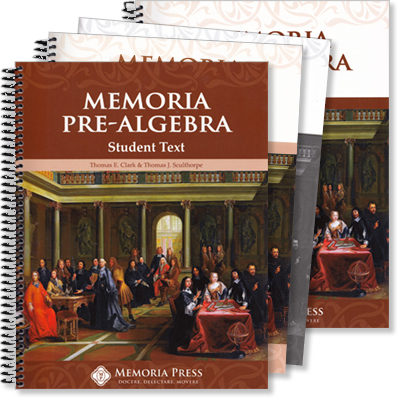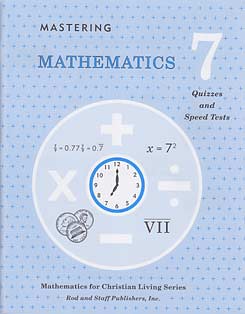
Memoria Pre-Algebra Set
- 4.186 lbs
Item #56-M-0--
| This set includes: | # in My Cart | ||
|---|---|---|---|
| Student Textbook | $35.00 | ||
| Quizzes and Tests | $20.00 | ||
| Solutions Key | $30.00 | ||
| Teacher's Manual | $35.00 | ||
| This set includes: 4 items | |||
First book in the Memoria Algebra Series.
Memoria Pre-Algebra functions as a student’s first year of algebra instruction. It finishes arithmetic with mastery of advanced computational skills and introduces algebraic terminology, concepts, and problem-solving methodology. This course achieves the latter through mastery of first-degree relations with one variable.
A readiness exam is available in the Teacher Manual for those who wish to confirm the student is prepared to succeed—the exam covers concepts typically completed in sixth grade.
The content of this course is a significant conceptual leap from what students have studied in arithmetic. Ensure that this first year of algebra instruction lays a strong and proper foundation by matching the rigor of the material with rigor in memorization of important terms and recitation, exercise completion and correction, and completion of the Quizzes & Tests. This course is the necessary prerequisite for Memoria Algebra I.
The Student Text's primary features, besides providing problem banks with which students can work toward mastery, include clear statements of lesson objectives, introduction and review of important terms, and detailed consideration of example problems. Ensure that students master the terms and utilize the examples as the main instructional tool as they move toward completing exercises independently. The first couple exercises can be used for further demonstration as required. All exercises should be completed, checked for accuracy, and corrected for each lesson, and problematic exercises can be repeated for mastery. An answer key for the odd exercises is included in the Appendix. Ensure that students have met the lesson objective before moving on.
The Quizzes & Tests is used to evaluate student progress. Often open-response questions are utilized that require students to state, in writing, their understanding of the concept under examination. This is an invaluable skill that ensures that students understand the mathematical concepts they are learning rather than becoming mere computers. Throughout this course, there are multiple quizzes, one at the conclusion of each part, and a test at the conclusion of each unit. Quizzes focus on the material in their respective parts, but exams are cumulative. There is also a Final Exam that should be attempted after intensive review. Mastery of the material presented in this course should translate to a score of 85 or greater on the Final Exam. Reserve Form B assessments for retakes or for Final Exam review in the closing weeks of the course.
The Teacher Manual serves as the primary instructional resource for the course and includes an answer key for all lesson exercises. Before presenting a lesson to students, thoroughly review the material and the teacher notes for helpful techniques and emphases. A teacher or homeschool instructor with an elementary understanding of algebra will be able to convey the lesson concepts and achieve the lesson objectives by understanding and following the material included in the Teacher Manual.
The Solutions Key contains complete, detailed solutions for every exercises to ensure comprehension.
A recitation schedule is located in the Appendix of the Student Text and Teacher Manual. Students should master the responses to the recitation questions for each lesson, reviewing recitation questions as necessary until they are mastered.
Contents
Unit I: Fundamentals
Part A: Mathematics as a Language
- 1. Mathematical Parts of Speech
- 2. Mathematical Expressions
- 3. Translation into Mathematical Symbols
Part B: Number Symbols and Our Number System
- 4. The Development of Our Number System
- 5. Fraction Forms and Decimal Forms
- 6. Changing Fraction Forms to Decimal Forms
- 7. Changing Decimal Forms to Fraction Forms
- 8. Percent
- 9. Evaluating Exponents
- 10. Primes, Composites, and Factoring
- 11. Least Common Multiple
- 12. Greatest Common Factor
Part C: Operation Symbols
- 13. Order of Operations
- 14. Properties of Operations
- 15. Properties of Operations with Special Numbers
- 16. Operations with Fractions—Multiplication
- 17. Operations with Fractions—Addition and Subtraction
- 18. Operations with Fractions—Division
- 19. Operations with Decimals
- 20. Operations with Signed Numbers—Vectors and Absolute Value
- 21. Operations with Signed Numbers—Addition
- 22. Operations with Signed Numbers—Subtraction
- 23. Operations with Signed Numbers—Multiplication and Division
Part D: Relation Symbols
- 24. Order of Numbers and the Number Line
- 25. Properties of Equality
- 26. Properties of Inequality
Part E: Mathematical Models
- 27. Sets and Set Notation
- 28. Function Notation
Unit II: First-Degree Relations with One Variable
Part A: Basic Equations and Inequalities
Part B: Complications in Equations and Inequalities
- 33. Grouping Symbols
- 34. Like Terms on the Same Side
- 35. Variables on Both Sides
- 36. Combinations
Part C: Special Cases in Equations and Inequalities
- 37. No Solution
- 38. Infinite Number of Solutions
Part D: Systems of Equations and Inequalities
- 39. Compound Sentences—Conjunctions
- 40. Compound Sentences—Disjunctions
- 41. Absolute Value Equal to a Positive Number
- 42. Absolute Value Less Than a Positive Number
- 43. Absolute Value Greater Than a Non-Negative Number
Part E: Problem Solving Using One Variable
- 44. General Strategy and Set-Up
- 45. Number Problems
- 46. Consecutive Integer Problems
- 47. Age Problems
- 48. Geometric Figure Problems
- 49. Motion Problems
- 50. Percent Problems
Unit III: Introduction to the Cartesian Coordinate System
- 51. Graphing Terminology
- 52. Solution Sets for Equations
- 53. Solution Sets for Inequalities
- 54. Graphing Techniques for y = mx
- 55. Graphing Techniques for y = mx + b
- 56. Graphing Techniques—Intercepts
Appendix
- Recitation
- Eratosthenes' Sieve
- Odd Exercise Key


![Grade 8 Science [Revised] "God's Orderly World" Set](http://www.milestonebooks.com/xcart/images/product/1-148--%2830%29.jpg)



![Grade 2 English [3rd Edition] "Preparing to Build" Set](http://www.milestonebooks.com/xcart/var/images/product/160.160/1-122--.jpg)